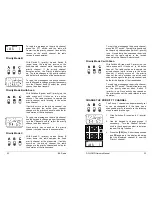
38 BK Radio
Master
Clone
Master
Switch
When the Master’s Command Group is cloned
to a slave, the channel data that is ‘pointed to’
by the Command Group is transferred to a
target group (not the Command Group) in the
slave. The target group’s label in the slave
will be set to ‘
CMND CLN
’.
NOTE:
Some groups may be “locked” by PC
programming to prevent them from
being overwritten. Only “unlocked”
groups will accept incoming clones.
1.
Make sure the battery packs for both
radios are charged.
2.
Attach the master switch end of the
cloning cable to the side connector of the
Master radio.
NOTE:
One plug of the cloning cable
has a push-button master
switch. This plug must be
attached to the Master radio.
3.
Turn on the Master radio.
4. Put the Master radio in Programming
Mode by pressing and holding the master
switch then pressing and holding the
[FCN]
key until the display shows
‘
PSWRD-******
’.
Enter the password of the
selected group. The display shows ‘
PRG
CH 00
.’
5.
Connect the other plug of the cable to the
side connector of the radio you want to
clone.
6. Turn on the clone and set it to the desired
channel group.
7. Press the
[*]
key on the Master radio
keypad. The radio will respond showing
the prompt ‘
PROG|DPHCMD
’ on the first
line and ‘
Group XX
’ on the second line,
where XX is the currently selected group.
PSWRD-******
CMND CLN
PRG
ch 00
PROG|D
PROG|D
PROG|D
PROG|DPHcmD
PHcmD
PHcmD
PHcmD
Group 01
Press and Hold
[#]
Key
to Change Data
DPH-CMD Owner’s Manual 7
RF EXPOSURE COMPLIANCE AND CONTROL GUIDELINES
AND OPERATING INSTRUCTIONS
To control your exposure and ensure compliance with the
occupational/controlled environment exposure limits always adhere to
the following procedures.
Guidelines:
•
Do not remove the RF Exposure Label from the device.
•
User awareness instructions must accompany device when
transferred to other users.
•
Do not use this device if the operational requirements described
herein are not met.
Operating Instructions:
•
Transmit no more than the rated duty factor of 50% of the time. To
transmit (talk), push the Push-To-Talk (PTT) button. To receive calls,
release the PTT button. Transmitting 50% of the time, or less, is
important because this radio generates measurable RF energy
exposure only when transmitting (in terms of measuring for standards
compliance).
•
Hold the radio in a vertical position in front of face with the
microphone (and the other parts of the radio, including the antenna)
at least one inch (2.5 cm) away from the nose. Keeping the radio at
the proper distance is important because RF exposures decrease
with distance from the antenna. Antenna should be kept away from
eyes.
•
When worn on the body, always place the radio in a BK Radio
approved clip, holder, holster, case, or body harness for this product.
Using approved body-worn accessories is important because the use
of BK Radio or other manufacturer’s non-approved accessories may
result in exposure levels which exceed the FCC’s
occupational/controlled environment RF exposure limits.
•
If you are not using a body-worn accessory and are not using the
radio in the intended use position in front of the face, then ensure the
antenna and the radio are kept at least one inch (2.5 cm) from the
body when transmitting. Keeping the radio at the proper distance is
important because RF exposures decrease with increasing distance
from the antenna.
•
Use only BK Radio approved supplied or replacement antennas,
batteries, and accessories. Use of non-BK Radio approved
antennas, batteries, and accessories may exceed the FCC RF
exposure guidelines. For a list of BK Radio approved accessories
visit the following website :
http://www.relm.com
.
CONTACT INFORMATION
For additional information on exposure requirements or other
information, visit website http://www.relm.com.
Summary of Contents for DPH- CMD
Page 22: ...DPH CMD Owner s Manual 43 NOTES ...
Page 23: ......







































